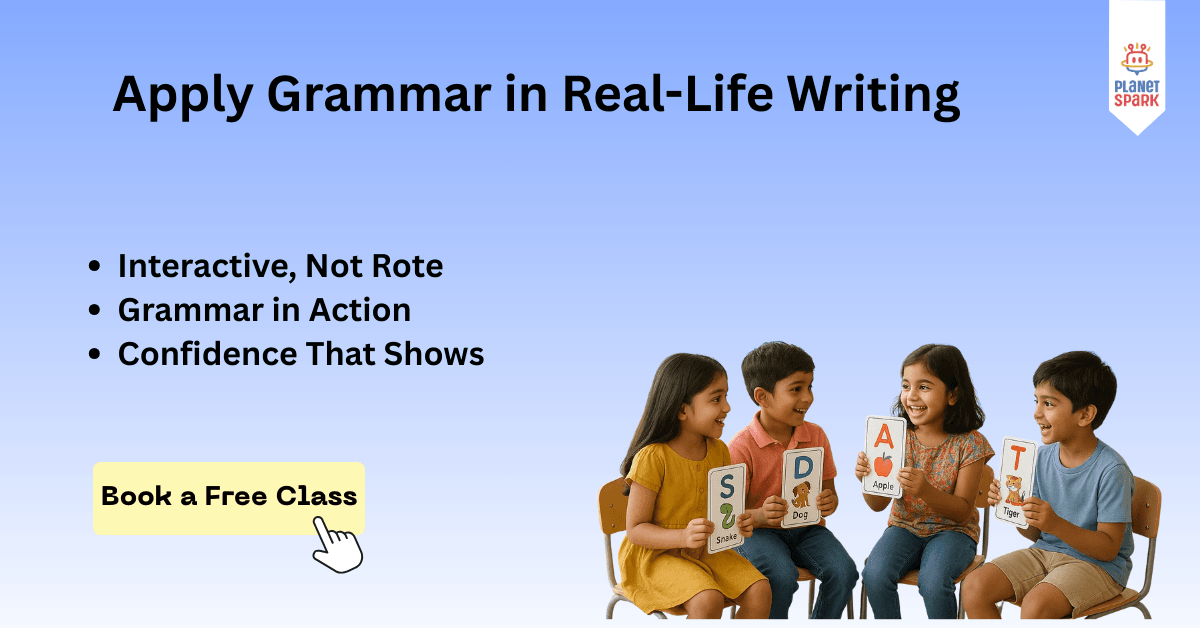Tag Questions: Definition, Rules, Examples, and Exercises

Table of Contents
- What is a Tag Question?
- Why Do We Use Question Tags?
- Rules of Tag Questions
- Types of Tag Questions
- Question Tags Examples in Daily Life
- Question Tags with Answers
- 20 Question Tag Examples with Answers
- Question Tags Rules Table
- Exercises on Tag Questions
- Common Mistakes in Tag Questions
- Why Learn Tag Questions?
- PlanetSpark English Grammar Course
- Frequently Asked Questions (FAQs)
In everyday conversations, English speakers often add short questions at the end of a statement, such as “It’s hot today, isn’t it?” or “You’re a student, aren’t you?” These little add-ons are called tag questions or question tags.
A tag question makes a statement interactive. Instead of just giving information, you invite the listener to agree, disagree, or confirm. Learning tag questions not only improves your grammar but also helps you sound natural, polite, and confident in English conversations.
What is a Tag Question?
A tag question is a short question added at the end of a statement. It is made using an auxiliary (helping) verb or a modal verb plus a subject pronoun. The purpose is to confirm, check, or seek agreement.
Examples:
You are from Delhi, aren’t you?
She doesn’t like ice cream, does she?
They can sing, can’t they?
In each sentence, the tag at the end is the question tag.

Why Do We Use Question Tags?
Tag questions are not just a grammar exercise. They serve specific communication purposes:
To confirm information: “You finished the project, didn’t you?”
To engage the listener: “It’s a nice day, isn’t it?”
To show politeness: “You’ll help me, won’t you?”
To express surprise or doubt: “He can dance, can’t he?”
In other words, tag questions make conversations smoother and more natural.
Book your free trial class with PlanetSpark and make grammar learning fun and easy.
Rules of Tag Questions
To use question tags correctly, you must follow some key rules.
1. Positive Statement → Negative Tag
When the statement is positive, the question tag is negative.
She is a teacher, isn’t she?
You can swim, can’t you?
2. Negative Statement → Positive Tag
When the statement is negative, the question tag is positive.
He isn’t at home, is he?
They don’t eat meat, do they?
3. Match the Auxiliary or Modal Verb
The auxiliary or modal verb in the statement must match the one in the tag.
You will help me, won’t you?
She can drive, can’t she?
4. Use of Do/Does/Did
If there is no auxiliary verb, use do/does/did.
He plays cricket, doesn’t he?
They liked the movie, didn’t they?
5. Use Pronouns in Tags
Always use pronouns, not nouns.
John is your friend, isn’t he?
The students are ready, aren’t they?
6. Intonation in Question Tags
Rising tone: when you are uncertain and genuinely ask.
Falling tone: when you expect confirmation.
Types of Tag Questions
There are different ways tag questions are used in English:
1. Confirmative Tags
Used to confirm information.
You are coming, aren’t you?
2. Negative-Positive Tags
When the main sentence is negative.
She doesn’t know you, does she?
3. Imperative Tags
To soften commands or requests.
Open the window, will you?
Let’s go for a walk, shall we?
4. Sarcastic Tags
Sometimes used to express disbelief or sarcasm.
Oh, you know everything, don’t you?
Question Tags Examples in Daily Life
Here are some common question tags examples:
It’s cold today, isn’t it?
She can’t dance, can she?
You’re tired, aren’t you?
They weren’t here yesterday, were they?
He speaks English, doesn’t he?
Question Tags with Answers
Let’s look at a few question tags with answers to practice:
You are happy, aren’t you? – Yes, I am.
She isn’t your sister, is she? – No, she isn’t.
They can run fast, can’t they? – Yes, they can.
It won’t rain today, will it? – No, it won’t.
He doesn’t eat meat, does he? – No, he doesn’t.

20 Question Tag Examples with Answers
Here’s a list of 20 question tag examples with answers for practice:
He is your brother, isn’t he? – Yes, he is.
You aren’t busy, are you? – No, I’m not.
They will arrive soon, won’t they? – Yes, they will.
She doesn’t like sweets, does she? – No, she doesn’t.
We should start early, shouldn’t we? – Yes, we should.
It isn’t late, is it? – No, it isn’t.
He can ride a bike, can’t he? – Yes, he can.
She wasn’t upset, was she? – No, she wasn’t.
You don’t smoke, do you? – No, I don’t.
They are studying, aren’t they? – Yes, they are.
She sings well, doesn’t she? – Yes, she does.
He wasn’t angry, was he? – No, he wasn’t.
We have met before, haven’t we? – Yes, we have.
She will call later, won’t she? – Yes, she will.
It hasn’t snowed, has it? – No, it hasn’t.
They had left early, hadn’t they? – Yes, they had.
He won’t forget, will he? – No, he won’t.
She speaks French, doesn’t she? – Yes, she does.
You can’t swim, can you? – No, I can’t.
They aren’t ready, are they? – No, they aren’t.
Book a free demo class at PlanetSpark and see how interactive learning makes grammar simple.
Question Tags Rules Table
Here’s a quick reference table for question tag rules:
| Statement Type | Question Tag Example |
|---|---|
| Positive statement | You are a student, aren’t you? |
| Negative statement | She isn’t coming, is she? |
| With auxiliary verb | They have finished, haven’t they? |
| Without auxiliary verb | He plays well, doesn’t he? |
| Imperative sentence | Don’t be late, will you? |
Exercises on Tag Questions
Exercise 1: Fill in the blanks
He is your friend, ______?
They won the match, ______?
You can’t drive, ______?
She wasn’t late, ______?
We are ready, ______?
Answers: isn’t he? didn’t they? can you? was she? aren’t we?
Exercise 2: Correct the errors
She is coming, isn’t it?
They plays football, don’t they?
He didn’t study, did he not?
We can do it, isn’t it?
Corrected:
She is coming, isn’t she?
They play football, don’t they?
He didn’t study, did he?
We can do it, can’t we?
Common Mistakes in Tag Questions
Wrong pronouns
Incorrect: John is tall, isn’t John?
Correct: John is tall, isn’t he?
Wrong auxiliary verbs
Incorrect: He likes tea, isn’t he?
Correct: He likes tea, doesn’t he?
Repeating nouns
Incorrect: The girls are ready, aren’t the girls?
Correct: The girls are ready, aren’t they?
Why Learn Tag Questions?
Learning tag questions helps in:
Improving fluency in English.
Making conversations interactive.
Sounding natural and confident.
Building strong grammar skills.

PlanetSpark English Grammar Course
At PlanetSpark, we know grammar should be learned through practice and interaction, not just memorization. That’s why our English Grammar Course is designed for learners to master concepts like tag questions, subject-predicate, tenses, and sentence structures with engaging lessons.
Features of the Course
Live Interactive Classes with expert mentors.
Fun Quizzes and Activities for practical learning.
Comprehensive Curriculum covering all grammar topics.
Confidence Building through speaking and writing practice.
Why Choose PlanetSpark?
Expert-designed curriculum.
Real-life application of grammar.
Regular assessments and feedback.
Boosts both accuracy and fluency.
Join PlanetSpark’s courses now and give your child the gift of fluent English.
Frequently Asked Questions (FAQs)
1. What is a tag question in English?
A tag question is a short question added at the end of a statement to confirm or seek agreement.
2. What are examples of question tags?
Examples: It’s hot, isn’t it? You don’t like it, do you?
3. What are the rules of tag questions?
Positive statement takes a negative tag, negative statement takes a positive tag.
4. How do you form question tags in present simple tense?
By using do/does. Example: She works here, doesn’t she?
5. Can tag questions be used with imperatives?
Yes. Example: Open the door, will you?
6. What is the difference between tag questions and normal questions?
A normal question seeks information (e.g., “Where do you live?”), while a tag question seeks confirmation (e.g., “You live in Delhi, don’t you?”).
7. Can we use tag questions in formal writing?
Tag questions are mostly used in spoken English and informal writing. In formal writing, they are less common but may appear in conversational texts like dialogues.
8. What is the intonation of tag questions?
Rising tone shows real doubt (e.g., “You’re coming, aren’t you?”).
Falling tone shows expectation of agreement (e.g., “It’s hot, isn’t it?”).
9. Are tag questions the same in British and American English?
Both use tag questions, but British English uses them more often in everyday speech. Americans sometimes use “right?” or “okay?” instead.
10. Can we use “let’s” with tag questions?
Yes. With “let’s,” the tag is usually shall we. Example: Let’s go for a walk, shall we?
11. What happens when the main sentence has “I am”?
The tag is usually aren’t I? Example: I am your friend, aren’t I?
12. Can tag questions be used for emphasis?
Yes. Example: You really love chocolate, don’t you?
Download Free Worksheets
Personalized Communication Report
Record a video to get a AI generated personalized communication report for your child

Hi There, want to try these
tips for your child with
LIVE with our expert coach?
Let's check your child's
English fluency

